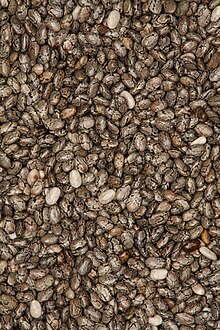Biotechnology is the use of living systems and organisms to develop or make products, or "any technological application that uses biological systems, living organisms, or derivatives thereof, to make or modify products or processes for specific use" (UN
Convention on Biological Diversity, Art. 2).
[1] Depending on the tools and applications, it often overlaps with the (related) fields of
bioengineering,
biomedical engineering,
biomanufacturing,
molecular engineering, etc.
Definitions[edit]
The wide concept of "biotech" or "biotechnology" encompasses a wide range of procedures for modifying living organisms according to human purposes, going back to
domesticationof animals, cultivation of the plants, and "improvements" to these through breeding programs that employ
artificial selection and
hybridization. Modern usage also includes
genetic engineering as well as
cell and
tissue culture technologies. The
American Chemical Society defines biotechnology as the application of biological organisms, systems, or processes by various industries to learning about the science of life and the improvement of the value of materials and organisms such as pharmaceuticals, crops, and livestock.
[3] As per
European Federation of Biotechnology, biotechnology is the integration of natural science and organisms, cells, parts thereof, and molecular analogues for products and services.
[4]Biotechnology also writes on
[clarification needed] the pure biological sciences (
animal cell culture,
biochemistry,
cell biology,
embryology,
genetics,
microbiology, and
molecular biology). In many instances, it is also dependent on knowledge and methods from outside the sphere of biology including:
Conversely, modern biological sciences (including even concepts such as
molecular ecology) are intimately entwined and heavily dependent on the methods developed through biotechnology and what is commonly thought of as the
life sciences industry. Biotechnology is the
research and development in the
laboratory using
bioinformatics for exploration, extraction, exploitation and production from any
living organisms and any source of
biomass by means of
biochemical engineering where high value-added products could be planned (reproduced by
biosynthesis, for example), forecasted, formulated, developed, manufactured, and marketed for the purpose of sustainable operations (for the return from bottomless initial investment on R & D) and gaining durable patents rights (for exclusives rights for sales, and prior to this to receive national and international approval from the results on animal experiment and human experiment, especially on the
pharmaceutical branch of biotechnology to prevent any undetected side-effects or safety concerns by using the products).
[5][6][7]
By contrast,
bioengineering is generally thought of as a related field that more heavily emphasizes higher systems approaches (not necessarily the altering or using of biological materials
directly) for interfacing with and utilizing living things. Bioengineering is the application of the principles of engineering and natural sciences to tissues, cells and molecules. This can be considered as the use of knowledge from working with and manipulating biology to achieve a result that can improve functions in plants and animals.
[8] Relatedly,
biomedical engineering is an overlapping field that often draws upon and applies
biotechnology (by various definitions), especially in certain sub-fields of biomedical or chemical engineering such as
tissue engineering, bio
pharmaceutical engineering, and
genetic engineering.
History[edit]

Brewing was an early application of biotechnology
Although not normally what first comes to mind, many forms of human-derived
agriculture clearly fit the broad definition of "'utilizing a biotechnological system to make products". Indeed, the cultivation of plants may be viewed as the earliest biotechnological enterprise.
Agriculture has been theorized to have become the dominant way of producing food since the
Neolithic Revolution. Through early biotechnology, the earliest farmers selected and bred the best suited crops, having the highest yields, to produce enough food to support a growing population. As crops and fields became increasingly large and difficult to maintain, it was discovered that specific organisms and their by-products could effectively
fertilize,
restore nitrogen, and
control pests. Throughout the history of agriculture, farmers have inadvertently altered the genetics of their crops through introducing them to new environments and
breeding them with other plants — one of the first forms of biotechnology.
These processes also were included in early
fermentation of
beer.
[9] These processes were introduced in early
Mesopotamia,
Egypt,
Chinaand
India, and still use the same basic biological methods. In
brewing, malted grains (containing
enzymes) convert starch from grains into sugar and then adding specific
yeasts to produce beer. In this process,
carbohydrates in the grains broke down into alcohols, such as ethanol. Later, other cultures produced the process of
lactic acid fermentation, which produced other preserved foods, such as
soy sauce. Fermentation was also used in this time period to produce
leavened bread. Although the process of fermentation was not fully understood until
Louis Pasteur's work in 1857, it is still the first use of biotechnology to convert a food source into another form.
Before the time of
Charles Darwin's work and life, animal and plant scientists had already used selective breeding. Darwin added to that body of work with his scientific observations about the ability of science to change species. These accounts contributed to Darwin's theory of natural selection.
[10]
For thousands of years, humans have used selective breeding to improve production of crops and livestock to use them for food. In selective breeding, organisms with desirable characteristics are mated to produce offspring with the same characteristics. For example, this technique was used with corn to produce the largest and sweetest crops.
[11]
Biotechnology has also led to the development of antibiotics. In 1928,
Alexander Fleming discovered the mold
Penicillium. His work led to the purification of the antibiotic compound formed by the mold by Howard Florey, Ernst Boris Chain and Norman Heatley – to form what we today know as
penicillin. In 1940, penicillin became available for medicinal use to treat bacterial infections in humans.
[11]
The field of modern biotechnology is generally thought of as having been born in 1971 when Paul Berg's (Stanford) experiments in gene splicing had early success. Herbert W. Boyer (Univ. Calif. at San Francisco) and Stanley N. Cohen (Stanford) significantly advanced the new technology in 1972 by transferring genetic material into a bacterium, such that the imported material would be reproduced. The commercial viability of a biotechnology industry was significantly expanded on June 16, 1980, when the
United States Supreme Courtruled that a
genetically modified microorganism could be
patented in the case of
Diamond v. Chakrabarty.
[13] Indian-born Ananda Chakrabarty, working for
General Electric, had modified a bacterium (of the genus
Pseudomonas) capable of breaking down crude oil, which he proposed to use in treating oil spills. (Chakrabarty's work did not involve gene manipulation but rather the transfer of entire organelles between strains of the
Pseudomonas bacterium.
Revenue in the industry is expected to grow by 12.9% in 2008. Another factor influencing the biotechnology sector's success is improved intellectual property rights legislation—and enforcement—worldwide, as well as strengthened demand for medical and pharmaceutical products to cope with an ageing, and ailing, U.S. population.
[14]
Rising demand for biofuels is expected to be good news for the biotechnology sector, with the
Department of Energy estimating
ethanol usage could reduce U.S. petroleum-derived fuel consumption by up to 30% by 2030. The biotechnology sector has allowed the U.S. farming industry to rapidly increase its supply of corn and soybeans—the main inputs into biofuels—by developing genetically modified seeds that resist pests and drought. By increasing farm productivity, biotechnology boosts biofuel production.
[15]
Examples[edit]

A
rose plant that began as cells grown in a tissue culture
Biotechnology has applications in four major industrial areas, including health care (medical), crop production and agriculture, non food (industrial) uses of crops and other products (e.g.
biodegradable plastics,
vegetable oil,
biofuels), and environmental uses.
For example, one application of biotechnology is the directed use of
organisms for the manufacture of organic products (examples include
beer and
milk products). Another example is using naturally present
bacteria by the mining industry in
bioleaching. Biotechnology is also used to recycle, treat waste, clean up sites contaminated by industrial activities (
bioremediation), and also to produce
biological weapons.
A series of derived terms have been coined to identify several branches of biotechnology; for example:
- Bioinformatics is an interdisciplinary field that addresses biological problems using computational techniques, and makes the rapid organization as well as analysis of biological data possible. The field may also be referred to as computational biology, and can be defined as, "conceptualizing biology in terms of molecules and then applying informatics techniques to understand and organize the information associated with these molecules, on a large scale."[16] Bioinformatics plays a key role in various areas, such as functional genomics, structural genomics, and proteomics, and forms a key component in the biotechnology and pharmaceutical sector.
- Blue biotechnology is a term that has been used to describe the marine and aquatic applications of biotechnology, but its use is relatively rare.
- Green biotechnology is biotechnology applied to agricultural processes. An example would be the selection and domestication of plants via micropropagation. Another example is the designing of transgenic plants to grow under specific environments in the presence (or absence) of chemicals. One hope is that green biotechnology might produce more environmentally friendly solutions than traditional industrial agriculture. An example of this is the engineering of a plant to express a pesticide, thereby ending the need of external application of pesticides. An example of this would be Bt corn. Whether or not green biotechnology products such as this are ultimately more environmentally friendly is a topic of considerable debate.
- Red biotechnology is applied to medical processes. Some examples are the designing of organisms to produce antibiotics, and the engineering of genetic cures through genetic manipulation.
- White biotechnology, also known as industrial biotechnology, is biotechnology applied to industrial processes. An example is the designing of an organism to produce a useful chemical. Another example is the using of enzymes as industrial catalysts to either produce valuable chemicals or destroy hazardous/polluting chemicals. White biotechnology tends to consume less in resources than traditional processes used to produce industrial goods.[17]
The investment and economic output of all of these types of applied biotechnologies is termed as "
bioeconomy".
Medicine[edit]
In medicine, modern biotechnology finds many applications in areas such as
pharmaceutical drug discoveries and production,
pharmacogenomics, and genetic testing (or genetic screening).

DNA microarray chip – some can do as many as a million blood tests at once

Computer-generated image of insulin hexamers highlighting the threefold
symmetry, the
zinc ions holding it together, and the
histidineresidues involved in zinc binding.
Biotechnology has contributed to the discovery and manufacturing of traditional
small molecule pharmaceutical drugs as well as drugs that are the product of biotechnology –
biopharmaceutics. Modern biotechnology can be used to manufacture existing medicines relatively easily and cheaply. The first genetically engineered products were medicines designed to treat human diseases. To cite one example, in 1978
Genentech developed synthetic humanized
insulin by joining its gene with a
plasmid vector inserted into the bacterium
Escherichia coli. Insulin, widely used for the treatment of diabetes, was previously extracted from the pancreas of
abattoir animals (cattle or pigs). The resulting genetically engineered bacterium enabled the production of vast quantities of synthetic human insulin at relatively low cost.
[23][24]Biotechnology has also enabled emerging therapeutics like
gene therapy. The application of biotechnology to basic science (for example through the
Human Genome Project) has also dramatically improved our understanding of
biology and as our scientific knowledge of normal and disease biology has increased, our ability to develop new medicines to treat previously untreatable diseases has increased as well.
[24]
Genetic testing allows the
genetic diagnosis of vulnerabilities to inherited
diseases, and can also be used to determine a child's parentage (genetic mother and father) or in general a person's
ancestry. In addition to studying
chromosomes to the level of individual genes, genetic testing in a broader sense includes
biochemical tests for the possible presence of genetic diseases, or mutant forms of genes associated with increased risk of developing genetic disorders. Genetic testing identifies changes in
chromosomes, genes, or proteins.
[25] Most of the time, testing is used to find changes that are associated with inherited disorders. The results of a genetic test can confirm or rule out a suspected genetic condition or help determine a person's chance of developing or passing on a
genetic disorder. As of 2011 several hundred genetic tests were in use.
[26][27] Since genetic testing may open up ethical or psychological problems, genetic testing is often accompanied by
genetic counseling.
Agriculture[edit]
Farmers have widely adopted GM technology. Between 1996 and 2011, the total surface area of land cultivated with GM crops had increased by a factor of 94, from 17,000 square kilometers (4,200,000 acres) to 1,600,000 km
2 (395 million acres).
[39] 10% of the world's crop lands were planted with GM crops in 2010.
[39] As of 2011, 11 different transgenic crops were grown commercially on 395 million acres (160 million hectares) in 29 countries such as the USA, Brazil, Argentina, India, Canada, China, Paraguay, Pakistan, South Africa, Uruguay, Bolivia, Australia, Philippines, Myanmar, Burkina Faso, Mexico and Spain.
[39]
Genetically modified foods are foods produced from
organisms that have had specific changes introduced into their
DNA with the methods of
genetic engineering. These techniques have allowed for the introduction of new crop traits as well as a far greater control over a food's genetic structure than previously afforded by methods such as
selective breeding and
mutation breeding.
[40] Commercial sale of genetically modified foods began in 1994, when
Calgene first marketed its
Flavr Savr delayed ripening tomato.
[41] To date most genetic modification of foods have primarily focused on
cash crops in high demand by farmers such as
soybean,
corn,
canola, and
cotton seed oil. These have been engineered for resistance to pathogens and herbicides and better nutrient profiles. GM livestock have also been experimentally developed, although as of November 2013 none are currently on the market.
[42]
There is a
scientific consensus[43][44][45][46] that currently available food derived from GM crops poses no greater risk to human health than conventional food,
[47][48][49][50][51] but that each GM food must be tested on a case-by-case basis before introduction.
[52][53][54] Nonetheless, members of the public are much less likely than scientists to perceive GM foods as safe.
[55][56][57][58] The legal and regulatory status of GM foods varies by country, with some nations banning or restricting them, and others permitting them with widely differing degrees of regulation.
[59][60][61][62]
GM crops also provide a number of ecological benefits, if not used in excess.
[63] However, opponents have objected to GM crops per se on several grounds, including environmental concerns, whether food produced from GM crops is safe, whether GM crops are needed to address the world's food needs, and economic concerns raised by the fact these organisms are subject to intellectual property law.
Industrial[edit]
Industrial biotechnology (known mainly in Europe as white biotechnology) is the application of biotechnology for industrial purposes, including
industrial fermentation. It includes the practice of using
cells such as
micro-organisms, or components of cells like
enzymes, to generate
industrially useful products in sectors such as chemicals, food and feed, detergents, paper and pulp, textiles and
biofuels.
[64] In doing so, biotechnology uses renewable raw materials and may contribute to lowering greenhouse gas emissions and moving away from a petrochemical-based economy.
[65]
Environmental[edit]
The environment can be affected by biotechnologies, both positively and adversely. Vallero and others have argued that the difference between beneficial biotechnology (e.g.bioremediation is to clean up an oil spill or hazard chemical leak) versus the adverse effects stemming from biotechnological enterprises (e.g. flow of genetic material from transgenic organisms into wild strains) can be seen as applications and implications, respectively.
[66] Cleaning up environmental wastes is an example of an application of environmental biotechnology; whereas loss of biodiversity or loss of containment of a harmful microbe are examples of environmental implications of biotechnology.
Regulation[edit]
The regulation of genetic engineering concerns approaches taken by governments to assess and manage the risks associated with the use of
genetic engineering technology, and the development and release of genetically modified organisms (GMO), including
genetically modified crops and
genetically modified fish. There are differences in the regulation of GMOs between countries, with some of the most marked differences occurring between the USA and Europe.
[67] Regulation varies in a given country depending on the intended use of the products of the genetic engineering. For example, a crop not intended for food use is generally not reviewed by authorities responsible for food safety.
[68] The European Union differentiates between approval for cultivation within the EU and approval for import and processing. While only a few GMOs have been approved for cultivation in the EU a number of GMOs have been approved for import and processing.
[69] The cultivation of GMOs has triggered a debate about coexistence of GM and non GM crops. Depending on the coexistence regulations incentives for cultivation of GM crops differ.
[70]
Learning[edit]
In 1988, after prompting from the
United States Congress, the
National Institute of General Medical Sciences (
National Institutes of Health) (NIGMS) instituted a funding mechanism for biotechnology training. Universities nationwide compete for these funds to establish Biotechnology Training Programs (BTPs). Each successful application is generally funded for five years then must be competitively renewed.
Graduate students in turn compete for acceptance into a BTP; if accepted, then stipend, tuition and health insurance support is provided for two or three years during the course of their
Ph.D. thesis work. Nineteen institutions offer NIGMS supported BTPs.
[71] Biotechnology training is also offered at the undergraduate level and in community colleges.








